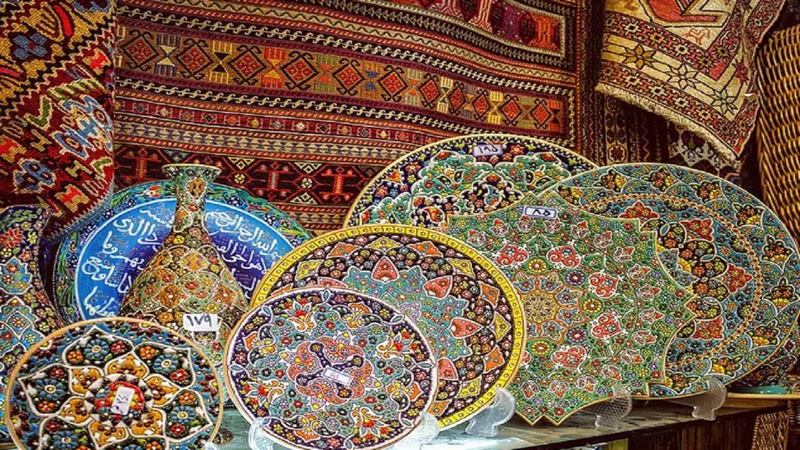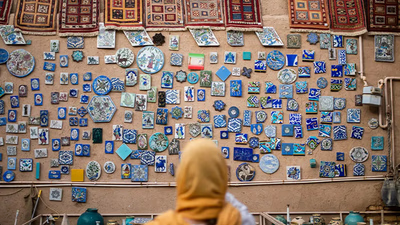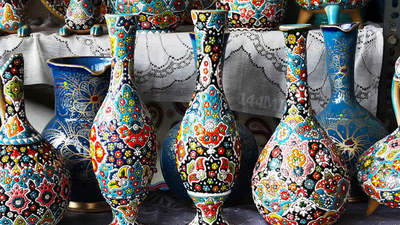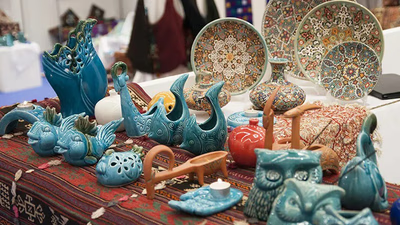
Diverse Islamic arts and crafts showcase regional heritage and creativity.
Islamic lands, despite the diversity in customs and culture, each has formed a unique artistic heritage, which is collectively known as Islamic art. The spread and influence of Islam in the countries of West Asia caused the emergence of new arts such as the art of ceramic making, lamp making, and the art of painting and calligraphy on glass. Islamic art is known from its name, it is called art that was created after the birth of Islam. An art based on Islamic beliefs and principles. Perhaps the most obvious feature of Islamic art is that it does not allow sculpting and face painting and portraits in general.
Calligraphy holds a significant place in Islamic art. Arabic calligraphy, particularly Quranic verses and religious texts, is intricately written and often used to decorate mosques, manuscripts, ceramics, and architectural elements. Arabesque patterns consist of interlacing geometric shapes, often based on plant motifs. These designs are prevalent in Islamic architecture, including intricate tilework, woodcarving, and plasterwork seen in mosques and palaces. Persian miniature painting flourished during the Islamic Golden Age. These small-scale paintings depict historical events, literary scenes, and mythological narratives. They are characterized by detailed brushwork, vibrant colors, and intricate patterns.
Ottoman illumination, known as \"Tezhip\" or \"Ebru,\" involves the intricate decoration of manuscripts, calligraphic panels, and other surfaces with gold leaf, colorful pigments, and delicate geometric and floral designs. Zellige is a form of Islamic tilework found in Moroccan architecture. It consists of intricate geometric mosaic patterns created by assembling small, colorful tiles to form elaborate designs on walls, floors, and fountains. Ebru is the art of creating colorful patterns on water using pigments, which are then transferred onto paper. This technique produces mesmerizing, marbled designs used in bookbinding, calligraphy, and as standalone artworks.
Iraq has a rich tradition of wood carving, particularly seen in the intricate Mashrabiya screens. These wooden latticework screens, found in traditional Iraqi architecture, feature geometric patterns and allow for airflow and privacy simultaneously. The advice of Islam is to avoid painting and making pictures of people on the walls of your house and buildings. Instead of this design of flowers and plants, nature, geometric designs such as Shamsi, Khatibi design and other geometric designs are used to the highest extent in Islamic art.
Islamic art is a word that was first used by orientalists and they started researching in this field. Islamic art has been the subject of research for Western scholars since the 19th century and for Western-educated Muslim scholars in recent decades, meaning that the name was not recognized by its creators, but the term \"Islamic art\" first appeared in English academic settings. It was defined and then by French researchers - who are the first academic explorers of Islamic works - and then by other western explorers, it was finally extended to the definition of Islamic art and architecture.
Iran has a long history of metalwork, particularly in copper, brass, and silver. Skilled artisans create intricately engraved and hammered metal objects such as bowls, trays, candleholders, and decorative items featuring geometric and floral motifs. Hebron tiles, originating from the city of Hebron in Palestine, are known for their blue and white color palette and beautiful geometric patterns. These tiles are used for architectural decoration and can be found in mosques and traditional Palestinian homes. Sadu weaving is a traditional craft of Saudi Arabia, particularly practiced by Bedouin communities. It involves the weaving of intricate geometric patterns and symbols in vibrant colors on textiles and carpets using a vertical loom.
-

West Asia is a significant hub for handicrafts, blending art and culture across 14 countries. This industry not only preserves cultural heritage but also generates income, with June 10th recognized as World Handicrafts Day. The region boasts renowned products such as Persian carpets, Turkish ceramics, Palestinian embroidery, and Yemeni jewelry, showcasing intricate craftsmanship and vibrant designs. However, despite its rich artistic legacy, the handicraft sector faces challenges, including economic instability and competition in international markets. Many artisans struggle to maintain their livelihoods due to ongoing conflicts in countries like Syria and Yemen. The potential for West Asia to become a major exporter of handicrafts is hindered by a lack of supportive policies and infrastructure. With over 295 registered handicraft fields and a community of 2 million involved in this sector, there is a pressing need for governments to implement protective measures and promote this valuable cultural industry. Addressing these issues could revitalize the handicraft market, enhance employment opportunities, and preserve the region"s artistic identity."
-

Handicrafts and traditional crafts represent skilled craftsmanship that creates decorative and functional items using traditional methods. These crafts are deeply rooted in the culture and heritage of specific regions, often reflecting local traditions and aesthetics. They are typically handmade, employing simple tools and materials, and are characterized by their cultural significance and economic potential. Handicrafts can include pottery, textiles, woodwork, metalwork, and more, each showcasing the unique artistry of the artisans. The production of handicrafts requires minimal investment and can foster development in disadvantaged areas, contributing to local economies. The crafts often carry high added value compared to other industries and rely on domestic raw materials. As societies evolve, the importance of preserving these traditional crafts remains, as they not only provide income for artisans but also enhance cultural tourism. The Arts and Crafts movement, which began in the 19th century, continues to inspire a renewed appreciation for handmade goods and the cultural narratives they embody.
-

Islamic art encompasses a diverse range of artistic expressions rooted in Islamic beliefs and principles across West Asia. This art form emerged following the advent of Islam, characterized by its prohibition of sculpting and portraiture. Instead, it emphasizes calligraphy, particularly Arabic calligraphy, which adorns various surfaces including mosques and manuscripts. Geometric patterns, known as arabesques, are prevalent in Islamic architecture, manifesting in intricate tilework and woodcarving. Notable styles include Persian miniature painting, Ottoman illumination, and Moroccan Zellige tilework. Techniques such as Ebru, which creates marbled designs on water, and traditional wood carving from Iraq further illustrate the richness of Islamic art. The historical context of Islamic art has attracted scholarly attention since the 19th century, leading to a deeper understanding of its significance and evolution. Regions like Iran and Palestine contribute unique crafts, including metalwork and Hebron tiles, showcasing the cultural diversity within Islamic art.
Sadu weaving from Saudi Arabia highlights the intricate craftsmanship of Bedouin communities, emphasizing the importance of textiles and patterns in this artistic heritage. Overall, Islamic art reflects a blend of spirituality, cultural identity, and artistic innovation, making it a vital aspect of the region"s heritage and trade."
-

Traditional industries and handicrafts are vital to the economies of Asian countries, providing employment and enhancing living standards. The global market for these products has expanded significantly, especially since the 1990s, leading to improved marketing strategies in wealthier nations. Notable art forms include Chinese calligraphy, Japanese origami, and Indian textiles, each showcasing unique cultural heritage. Countries like Korea and Thailand are recognized for their distinct pottery and silk weaving techniques, respectively. Indonesia"s batik and Tibetan thangkas further illustrate the diversity of Asian crafts. Vietnamese lacquerware and Persian miniature painting highlight the intricate artistry found throughout the region. Central Asia boasts a rich tradition of handicrafts, with local workshops offering immersive experiences for tourists. Despite extensive research, the origins of these art forms remain somewhat ambiguous, with many historians suggesting that they first emerged in India before spreading across Asia. The blend of tradition and modernity in these crafts continues to attract global interest, making them an essential component of the region"s trade landscape.




